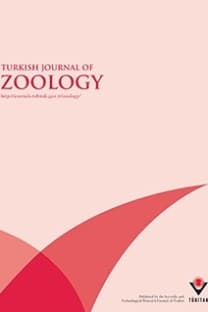Local concentration of foraging noctule bats (Nyctalus noctula) as a possible tool to assess the density of bats in large forest complexes
Key words: Aerial hawking bats, density of bats, breeding colonies, feeding grounds
Local concentration of foraging noctule bats (Nyctalus noctula) as a possible tool to assess the density of bats in large forest complexes
___
- Betke M, Hirsh DE, Makris NC, McCracken GF, Procopio M, Hristov NI, Tang S, Bagchi A, Reichard JD, Horn JW et al. (2008). Thermal imaging reveals significantly smaller Brazilian free-tailed bat colonies than previously estimated. J Mammal 89: 18–24.
- Červenı J, Bürger P (1989). Density and structure of bat community occupying an old park (Žihobce, Czechoslovakia). In: Hanák V, Horácek I, Gaisler J, editors. European Bat Research Symposium 1987. Prague, Czech Republic: Charles University Press, pp. 475–488.
- Dechmann DKN, Heucke SL, Giuggioli L, Safi K, Voigt CC, Wikelski M (2009). Experimental evidence for group hunting via eavesdropping in echolocating bats. Proc R Soc Lond B Biol Sci 276: 2721–2728.
- Gaisler J, Hanák V, Dungel J (1979). A contribution to the population ecology of Nyctalus noctula (Mammalia: Chirotera). Act Sci Nat Brno 13: 1–38.
- Horn JW, Kunz TH (2008). Analyzing NEXRAD Doppler radar images to assess nightly dispersal patterns and population trends in Brazilian free-tailed bats (Tadarida brasiliensis). Integr Comp Biol 48: 24–39.
- Kunz TH, Whitaker JO, Wadanoli MD (1995). Dietary energetics of the insectivorous Mexican free-tailed bat (Tadarda brasilensis) during pregnancy and lactation. Oecologia 101: 407–415.
- Mackie LJ, Racey PA (2007). Habitat use varies with reproductive state in noctule bats (Nyctalus noctula): implications for conservation. Biol Conserv 140: 70–77.
- McCarty JP (1997). Aquatic community characteristics influence the foraging patterns of tree swallows. Condor 99: 2010–2013.
- NORDECO and DENR (2001). BMS Manual Supplement on Method for Counting Waterbirds. Manila, the Philippines: DENR, and Copenhagen, Denmark: NORDECO.
- Obrist MK, Boesch R, Flückiger PF (2004). Variability in echolocation call design of 26 Swiss bat species: consequences, limits and options for automated field identification with a synergetic pattern recognition approach. Mammal 68: 307–322.
- Ruczyński I, Nicholls B, MacLeod CD, Racey PA (2010). Selection of roosting habitats by Nyctalus noctula and Nyctalus leisleri in Białowieża Forest—adaptive response to forest management? Forest Ecol Manag 259: 1633–1641.
- Russo D, Jones G (2002). Identification of twenty-two bat species (Mammalia: Chiroptera) from Italy by analysis of timeexpanded recordings of echolocation calls. J Zool Lond 258: 91–103.
- Rydell J, Petersons G (1998). The diet of the noctule bat Nyctalus noctula in Latvia. Z Saugetierkd 63: 79–83.
- Safi K, Kerth G (2007). Natural history miscellany: comparative analyses suggest that information transfer promoted sociality in male bats in the temperate zone. Am Natural 170: 465–472.
- Scheffer M, van Geest GJ, Zimmer K, Jeppesen E, Sondergaard M, Butler MG, Hanson MA, Declerck S, De Meester L (2006). Small habitat size and isolation can promote species richness: second-order effects on biodiversity in shallow lakes and ponds. Oikos 112: 227–231.
- Speakman JR (2008). The physiological costs of reproduction in small mammals. Philos T R Soc B 363: 375–398.
- Walters CL, Freeman R, Collen A, Dietz C, Fenton MB, Jones G, Obrist MK, Puechmaille S J, Sattler T, Siemers BM et al. (2012). A continental-scale tool for acoustic identification of European bats. J App Ecol 49: 1064–1074.
- ISSN: 1300-0179
- Yayın Aralığı: 6
- Yayıncı: TÜBİTAK
Ahmet BOZKURT, Mehmet Fatih CAN
Sophia METALLAOUI, Mohamed Chérif MAAZI, Menouar SAHEB, Moussa HOUHAMDI, Christophe BARBRAUD
Hüseyin ARIKAN, Bayram GÖÇMEN, Naşit İĞCİ, Bahadır AKMAN
Yüksel COŞKUN, Nursel Aşan BAYDEMİR, Alaettin KAYA, Ayşe Merve KARÖZ
Baoming GE, Daizhen ZHANG, Boping TANG, Chunlin ZHOU
Selective predation on common voles by Tawny Owls and Long-eared Owls in winter and spring
Linas BALCIAUSKAS, Laima BALCIAUSKIENE
